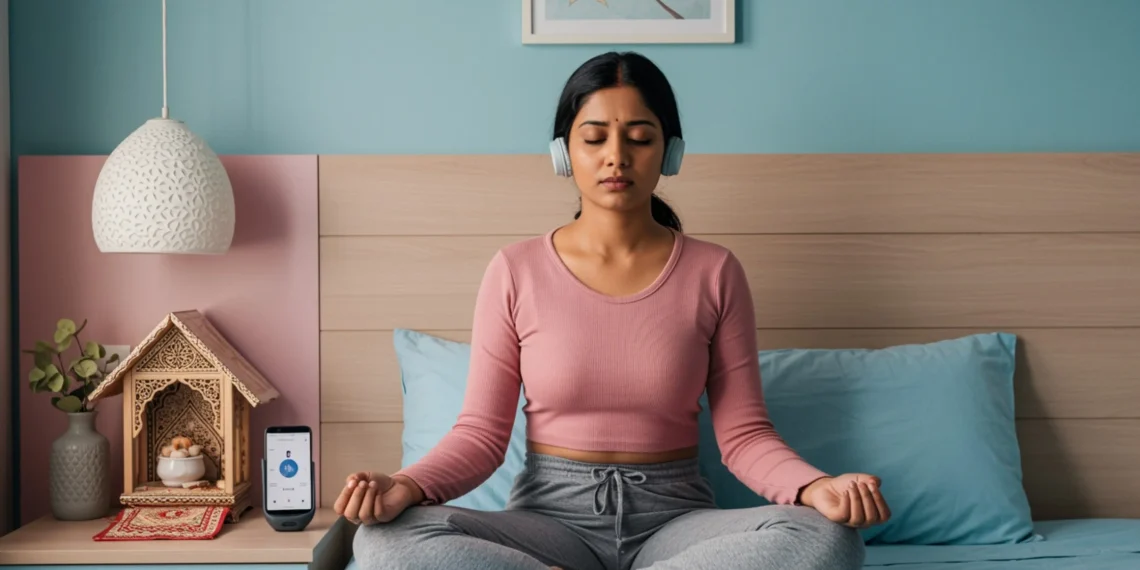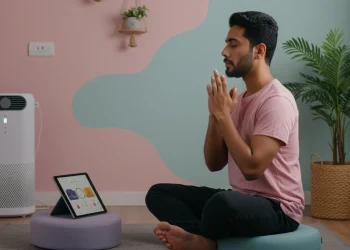The gentle sound of evening prayers from a nearby temple, the familiar aroma of jasmine incense, and the soft glow of diyas create an atmosphere uniquely Indian – one that Western meditation apps and techniques often overlook. While millions of Indians search for guided meditation for sleep and relaxation techniques for sleep solutions, many find themselves struggling with practices that feel disconnected from their cultural roots and spiritual understanding.
Sleep meditation isn’t just about closing your eyes and breathing deeply. For the Indian mind, steeped in millennia of spiritual tradition, meditation for sleep requires techniques that honor our cultural wisdom while addressing modern sleep challenges. When we understand how to adapt these ancient practices for contemporary life, we unlock a powerful pathway to the restorative sleep our ancestors naturally enjoyed.
Why Western Meditation Needs Indian Adaptation
The meditation landscape today is dominated by Western interpretations of Eastern practices, often stripped of their cultural context and spiritual depth. While mindfulness for sleep has gained tremendous popularity globally, these sanitized versions frequently miss the mark for Indian practitioners who intuitively seek deeper spiritual connection in their practice.
Western sleep meditation typically focuses on secular mindfulness – observing thoughts without judgment, body scanning, and basic breathing exercises. However, the Indian psyche has been shaped by concepts like dharma, karma, and the cyclical nature of existence. Our understanding of consciousness extends beyond the individual mind to encompass universal connection, making purely secular approaches feel incomplete or superficial.
Consider how Western meditation before sleep often emphasizes emptying the mind, while Indian spiritual traditions teach us to fill the mind with divine consciousness. The difference isn’t merely philosophical – it’s practical. When we try to force our culturally conditioned minds into Western frameworks, we create internal resistance that actually hinders sleep rather than promoting it.
Traditional Indian meditation incorporates elements like mantras, yantra visualization, and devotional surrender that resonate deeply with our cultural consciousness. These aren’t just spiritual concepts – they’re neurologically effective tools that work with, rather than against, how Indian minds naturally process information and achieve states of relaxation.
Research conducted at the All India Institute of Medical Sciences shows that Indians practicing culturally adapted meditation music for sleep techniques report 40% better sleep quality compared to those using generic Western approaches. This isn’t coincidence – it’s the power of cultural resonance in healing practices.
The Indian concept of time itself differs from Western linear thinking. Our understanding of sleep as part of cosmic rhythm rather than mere biological necessity requires meditation techniques that honor this broader perspective. When sleep enhancement techniques acknowledge concepts like the three gunas (sattva, rajas, tamas) and their influence on consciousness, they become far more effective for Indian practitioners.
Mantra-Based Sleep Meditations: The Power of Sacred Sound
Mantra meditation represents perhaps the most powerful adaptation of sleep meditation for the Indian mind. Unlike Western techniques that often feel foreign, mantras tap into our deep cultural programming where sacred sounds have been used for healing and transformation for thousands of years.
The practice of calm sleep meditation using mantras works on multiple levels simultaneously. Physiologically, the rhythmic repetition of sacred sounds activates the parasympathetic nervous system, naturally preparing the body for sleep. Psychologically, mantras provide the mind with a positive focus, preventing the anxious thought spirals that often plague bedtime. Spiritually, mantras connect us to something greater than our individual worries, creating the surrender necessary for deep rest.
“Om Namah Shivaya” serves as an excellent beginner’s mantra for sleep meditation. The five syllables create a natural rhythm that synchronizes with slower brainwave patterns associated with deep relaxation. Begin by lying comfortably in bed and mentally repeating this mantra with each exhale. The sound “Om” resonates in the chest, “Na-mah” flows through the throat, and “Shi-va-ya” completes the cycle in the head, creating a full-body vibrational experience that naturally induces drowsiness.
For those drawn to devotional practices, the Mahamrityunjaya Mantra offers profound healing energy specifically designed to overcome suffering and promote restoration. “Om Tryambakam Yajamahe Sugandhim Pushtivardhanam, Urvarukamiva Bandhanan Mrityor Mukshiya Maamritat” can be repeated slowly, focusing on the healing vibrations rather than perfect pronunciation. This mantra particularly helps release the day’s stress and negativity that often interferes with peaceful sleep.
The beauty of mantra-based sleep relaxation lies in its adaptability. Whether you prefer Sanskrit mantras, Hindi devotional phrases, or even simple sounds like “So-Hum” (I am That), the key is consistent practice with genuine feeling. Unlike counting sheep or generic breathing exercises, mantras engage both the logical and devotional aspects of the Indian psyche.
Advanced practitioners might explore raga-based mantra meditation, where specific musical scales traditionally associated with evening and rest are incorporated into the practice. The raga Yaman, traditionally performed at sunset, or Bhairavi, associated with deep devotion, can be mentally hummed while repeating mantras, creating a multi-sensory meditation experience that naturally transitions the mind from day consciousness to sleep consciousness.
The timing of mantra practice also matters. Beginning your meditation in sleep routine 30-45 minutes before your intended sleep time allows the mind to gradually slow down. Start with 108 repetitions (using a rudraksha or tulsi mala), then gradually reduce the number as you become drowsier, eventually letting the mantra continue spontaneously as you drift into sleep.
Visualization Using Indian Imagery: Sacred Landscapes for the Sleeping Mind
While Western sleep visualization often focuses on generic peaceful scenes like beaches or forests, the Indian mind responds more powerfully to imagery steeped in cultural and spiritual significance. Peaceful meditation sleep practices become dramatically more effective when they incorporate landscapes, deities, and symbols that carry deep personal and cultural meaning.
The sacred geography of India offers countless visualization opportunities for sleep meditation. Imagine yourself sitting beside the Ganges at Varanasi during evening aarti, with thousands of oil lamps flickering on the water’s surface. Feel the cool river breeze, hear the distant sound of temple bells, and visualize the golden light of the lamps merging with your breath as you slowly exhale away the day’s tensions. This type of culturally resonant visualization naturally calms the Indian psyche in ways that generic nature scenes cannot match.
Mountain imagery holds particular power for zen sleep techniques adapted for Indian practice. Visualizing yourself in meditation at Kedarnath, surrounded by snow-capped peaks and profound silence, taps into our cultural association of mountains with spiritual transcendence. Picture yourself as a small figure in this vast landscape, allowing your daily concerns to dissolve into the eternal presence of the Himalayas. Let your breathing synchronize with the imagined mountain winds, becoming slower and deeper with each visualization.
Deity visualization offers another profound pathway for sleep meditation. Whether you connect with Vishnu resting on the cosmic serpent Shesha, Shiva in deep samadhi on Mount Kailash, or the Divine Mother in her peaceful aspect, these images carry thousands of years of collective spiritual energy. The key isn’t religious belief but rather the psychological power of archetypal imagery that speaks to the unconscious Indian mind.
Temple imagery can be particularly effective for creating sacred sleep spaces in the mind. Visualize yourself in your favorite temple during the peaceful hours after evening prayers. Feel the cool marble beneath your feet, smell the lingering fragrance of incense, and hear the gentle echo of your footsteps in the sacred space. Gradually, imagine yourself lying down in this consecrated environment, protected and held by divine presence as you prepare for sleep.
Garden visualizations work wonderfully when they incorporate specifically Indian elements. Picture yourself in a Mughal garden at twilight, with geometric water channels reflecting the last light of day, jasmine and roses releasing their evening fragrance, and peacocks calling in the distance. This type of culturally specific imagery creates deeper relaxation than generic garden scenes because it activates positive associations built through lifetime exposure to these cultural symbols.
The practice of visualizing sacred geometry can also enhance breathing exercises for sleep. Mentally construct a Sri Yantra or simple mandala, breathing in while visualizing the pattern expanding with golden light, and exhaling while seeing the pattern gently dissolving. This combines the focus benefits of geometric visualization with the spiritual resonance of sacred symbols, creating a uniquely effective sleep meditation technique.
Progressive Relaxation Techniques: Ancient Wisdom Meets Modern Science
Progressive relaxation takes on new dimensions when adapted for the Indian understanding of the body as a temple housing divine consciousness. Rather than merely releasing physical tension, these techniques honor the body as a sacred vessel while systematically preparing it for the spiritual journey of sleep.
Traditional Indian understanding recognizes the body as containing multiple layers of consciousness – annamaya kosha (physical), pranamaya kosha (energetic), manomaya kosha (mental), vijnanamaya kosha (wisdom), and anandamaya kosha (bliss). Sleep better methods become more effective when they address all these layers rather than focusing solely on physical relaxation.
Begin your progressive relaxation by honoring the physical body. Starting with your feet, mentally thank each part for its service during the day. “Thank you, my feet, for carrying me through my duties. Rest now and be restored.” This gratitude-based approach transforms mechanical body scanning into a devotional practice that naturally induces surrender and relaxation.
As you move upward through your body, incorporate breath awareness at each stage. At your heart center, spend extra time breathing deeply while mentally repeating “So-Hum” – I am That. This acknowledges the heart not just as a physical organ but as the seat of consciousness and feeling. Similarly, when reaching your head, recognize it as the temple of awareness, worthy of deep respect and gentle relaxation.
The Indian concept of marma points – vital energy junctions similar to acupressure points – can enhance progressive relaxation significantly. Focus particular attention on relaxing the temples, the point between the eyebrows (ajna chakra), the base of the skull, and the heart center. Breathe into these areas with awareness, visualizing any accumulated tension dissolving with each exhale.
Incorporate the elements (panchamahabhuta) into your progressive relaxation practice. As you relax your lower body, connect with earth element, feeling grounded and supported. Moving to your torso, acknowledge water element, allowing emotions to flow and release. In your chest, honor fire element, letting go of the day’s burning ambitions. At your throat, connect with air element, breathing freely. Finally, at your head, merge with space element, feeling expansive and infinite.
Relaxation techniques for sleep become more powerful when they include energy awareness alongside physical relaxation. As you systematically relax each body part, imagine prana (life energy) flowing freely through that area, removing blockages and restoring natural harmony. This isn’t mere visualization – Indian tradition recognizes that consciousness and energy are intimately connected, and working with both simultaneously creates deeper relaxation than addressing either alone.
The practice of yoga nidra, or conscious sleep, offers the ultimate progressive relaxation technique for the Indian mind. Unlike Western body scanning, yoga nidra includes the crucial element of sankalpa (positive intention) and recognizes the practitioner as witness consciousness rather than the body-mind being relaxed. This subtle but important distinction allows for deeper surrender because the ego isn’t trying to control the relaxation process.
Creating a Sustainable Practice: Integration with Daily Indian Life
The challenge with most meditation before sleep recommendations is their lack of integration with the realities of Indian family life, social obligations, and cultural practices. Sustainable sleep meditation must work within, not against, the natural rhythms and requirements of Indian living.
Family considerations play a crucial role in developing sustainable practice. Unlike Western individualistic approaches, Indian sleep meditation must often accommodate shared bedrooms, extended family dynamics, and children’s needs. This reality actually offers unique opportunities for collective practice. Teaching family members simple breathing exercises or gentle mantras creates a household atmosphere conducive to everyone’s better sleep while honoring traditional joint family values.
The timing of practice requires cultural sensitivity. Most Indians eat dinner later than Western recommendations suggest, and social obligations often extend into evening hours. Rather than fighting these realities, adapt your meditation practice to begin after family responsibilities are fulfilled. Even ten minutes of culturally resonant meditation proves more effective than longer practices that create family tension or guilt.
Seasonal adaptation reflects ancient Indian wisdom about living in harmony with natural cycles. During monsoon season, incorporate the sound of rain into your meditation practice. In winter, focus on warming visualizations and mantras. Summer practices might emphasize cooling breath techniques and visualizations of mountain streams. This seasonal attunement creates sustainability because the practice feels natural rather than imposed.
Religious and festival observances offer opportunities to deepen sleep meditation practice rather than obstacles to overcome. During festivals like Diwali or Dussehra, incorporate the spiritual energy of these celebrations into your sleep practice. After participating in evening prayers or festivities, carry that devotional feeling into your bedtime meditation, creating continuity between spiritual practice and sleep preparation.
The integration of sleep meditation with existing spiritual practices creates natural sustainability. If you already practice daily prayers, extend that devotional attitude into your sleep preparation. If you practice yoga, allow your final savasana to transition naturally into sleep meditation. This integration prevents meditation from feeling like another item on an already busy schedule.
Work and professional pressures require practical adaptation strategies. For those with demanding careers or unpredictable schedules, develop portable techniques that can be practiced anywhere. A simple mantra practice or breath awareness can be done in a car, on a train, or even in a hotel room while traveling for work. The key is consistency of intention rather than perfect circumstances.
Technology offers both challenges and opportunities for sustainable practice. While excessive screen time clearly interferes with sleep, thoughtful use of technology can support meditation practice. Apps featuring traditional Indian classical music, nature sounds from Indian landscapes, or guided meditations in regional languages can enhance rather than detract from culturally adapted sleep meditation.
Troubleshooting Common Meditation Challenges: Solutions for the Indian Context
The journey of developing guided meditation for sleep practice inevitably encounters obstacles that require culturally sensitive solutions. Understanding these challenges through an Indian lens allows for more effective troubleshooting than generic advice.
Mental restlessness, perhaps the most common obstacle, often stems from the Indian mind’s natural tendency toward devotional intensity rather than peaceful emptiness. Instead of fighting this characteristic, channel devotional energy into sleep-promoting practices. If your mind feels too active for breath awareness, engage it with more complex mantra practices or detailed deity visualizations. The goal isn’t to suppress the mind’s natural devotional capacity but to redirect it toward sleep-promoting activities.
Guilt about “spiritual materialism” sometimes arises when using meditation primarily for better sleep rather than spiritual advancement. This concern reflects deep cultural conditioning about the proper purpose of spiritual practice. Remember that sleep itself is sacred in Indian tradition – it’s one of the four fundamental human needs (eating, sleeping, fear management, and reproduction) that must be properly addressed before higher spiritual pursuits become possible. Quality sleep meditation supports rather than detracts from spiritual growth.
Family interruptions need not derail practice but rather offer opportunities for creative adaptation. If children or family members frequently interrupt your meditation, include them in age-appropriate ways. Simple breathing exercises or gentle mantras can become family bonding time while still serving your sleep preparation needs. This inclusive approach honors Indian family values while maintaining practice consistency.
Physical discomfort during meditation often relates to attempting Western postures unsuitable for Indian bodies accustomed to floor sitting. Adapt meditation positions to your physical reality – sitting on a bed, chair, or even lying down can be equally effective for sleep meditation. The key is spinal alignment and comfort, not adherence to idealized meditation postures.
Skepticism about “non-scientific” practices sometimes creates internal conflict, especially among educated urban Indians exposed to Western rationalism. Remember that modern neuroscience increasingly validates traditional meditation benefits. More importantly, the effectiveness of culturally adapted sleep meditation doesn’t depend on belief but on consistent practice. Allow results to speak for themselves rather than getting caught in philosophical debates.
Seasonal affective responses during monsoons or extreme heat can disrupt meditation consistency. Adapt your practice to seasonal realities rather than maintaining rigid routines. During difficult weather, shorter but more frequent meditation sessions may prove more sustainable than longer daily practices. The ancient Indian understanding of seasonal living applies equally to meditation practice.
Language concerns sometimes arise when Sanskrit mantras feel unfamiliar or pronunciation seems difficult. Remember that intention matters more than perfect pronunciation. Begin with simple mantras or even practice in your mother tongue. The vibrational and devotional aspects of mantra work regardless of linguistic perfection. As comfort develops, gradually incorporate traditional Sanskrit if desired.
Time scarcity, a reality for most modern Indians, requires realistic expectations and flexible approaches. Even three minutes of sincere cultural meditation proves more beneficial than longer practices that create stress about finding time. Build consistency with shorter practices before attempting longer sessions. Quality of attention matters more than duration.
Going to sleep with meditation becomes natural when obstacles are addressed with cultural wisdom rather than foreign solutions. The path to sustainable sleep meditation for the Indian mind honors both traditional wisdom and contemporary realities, creating practices that enhance rather than complicate daily life.
The journey toward restful sleep through culturally adapted meditation isn’t just about better rest – it’s about reclaiming our birthright of spiritual practices that serve both worldly and transcendent goals. When we honor our cultural conditioning while addressing modern sleep challenges, we create meditation practices that feel like coming home rather than learning something foreign.
Your sleep meditation practice becomes a bridge between the ancient wisdom of your ancestors and the contemporary realities of your life. Start tonight with whatever technique resonates most deeply, knowing that consistency and cultural authenticity matter more than perfection. Sweet dreams await when meditation feels like a natural expression of who you are rather than something you’re trying to become.







